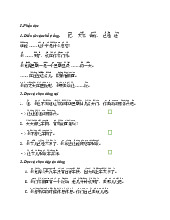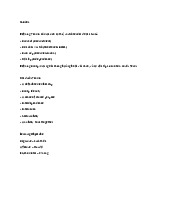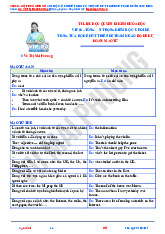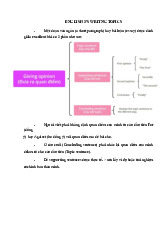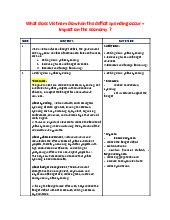





Preview text:
lOMoARcPSD|50582371
ÔN TẬP MÔN TIẾNG ANH 12C1.05
Mark the le*er A, B, C, or D to indicate the correct answer to each of the following ques;ons.
Ques;on 1: Judging by the -tles, Gary was a fan of ______ ac-on movies. A. violate B. violence C. violently D. violent
Ques;on 2: Shakespeare wrote “Romeo and Juliet” in 1605, ______? A. didn't he B. doesn't he C. won't he D. hasn't be
Ques;on 3:1 think it’s a bit of a ______ point because she got a very low mark for it. A. sore B. biIer C. hot D. salty
Ques;on 4: Tom only sees her ______ Christmas and Easter. A. in B. on C. at D. of
Ques;on 5: He suffered a serious ______ in a traffic accident which needed immediate hospital treatment. A. injury B. harm C. damage D. wound
Ques;on 6: ______ the windows are no-ceably smaller and the ceiling is lower than those in the main rooms, it is a light, bright space. A. Although B. Because C. Because of D. Despite
Ques;on 7: You can buy this ______ hat for £13.50, down from £45.
A. red small beau-ful small B. beau-ful red
C. red beau-ful small red D. beau-ful small
Ques;on 8: He doesn't have the funds to ______ his design. A. look out B. keep on C. carry on D. carry out
Ques;on 9: His mother ______ in her chair in the kitchen when I came in. A. was si[ng B. were si[ng C. are si[ng D. sit
Ques;on 10: I'l start to think about it ______.
A. while I was having to write my report.B. when I have to write my report,
C. before I had to write my report. D. a\er I had to write my report. Ques;on 11: They have been
______ some measures to control traffic jam at rush hours. A. imagined B. taken C. done D. carried
Ques;on 12: Public figures have a duty to ______ themselves responsibly, even in their private lives. A. affirm B. commit C. conduct D. organise Ques;on 13: Computers
______ in many fields - in business, science, medicine, and educa-on, for example. A. are used B. is used C. used D. uses
Ques;on 14: ______ New Jersey on January 19th, he arrived in San Francisco. A. Le\ B. Having le\ C. Leave D. To leave
Ques;on 15: He spent a year in India and loves spicy food. ______ the food is, the more he likes it. A. The hoIer B. The hoIest C. HoIer D. HoIest
Mark the le*er A, B, C, or D to indicate the op;on that best completes each of the following exchanges.
Ques;on 16: Tim wants to make an apology to Bil for having broken his racket.
Tim: “Sorry, I didn’t mean to do that.” Bil : ______”
A. You’ve to forget it!
B. Then what did you mean?
C. No problem. Don’t worry about it.
D. You can blame yourself.
Ques;on 17: Mol y is talking to Mike about doing volunteer work lOMoARcPSD|50582371
Mol y: “As far as I know, doing charity work is a really helpful thing for everyone in the society.”
Mike: “______. The more we give, the happier we feel” A. That sounds great.
B. I couldn’t agree with you more.
C. I’l take part in this campaign.
D. That’s fine for me.
Mark the le*er A, B, C or D to indicate the word that differs from the other three in the posi;on of
primary stress in each of the following ques;ons. Ques;on 18: A. confident B. excel ent C. marvelous
D. aIrac-ve Ques;on 19: A. manage B. fol ow C. decide D. comfort
Mark the le*er A, B, C, or D to indicate the word whose underlined part differs from the other three in
pronuncia;on in each of the following ques;ons.
Ques;on 20: A. complained B. conserved C. approached D. borrowed Ques;on 21: A. walk B. call C. talk D. take
Mark the le*er A, B, C, or D to indicate the word(s) CLOSEST in meaning to the underlined word(s) in
each of the following ques;ons.
Ques;on 22: The state government is determined to tackle the problem of poverty in the inner ci-es. A. solve B. encounter C. appeal D. impair
Ques;on 23: To comply with government hygiene regula;ons, there must be a separate sink for hand washing. A. principals B. principles C. priori-es D. primaries
Mark the le*er A, B, C, or D to indicate the word(s) OPPOSITE in meaning to the underlined word(s) in
each of the following ques;ons.
Ques;on 24 The local administra-on in Ha Tinh took a range of measures to reduce the drought and flood
risks in this area, but they just drew a blank. A. had a consequence
B. got a result C. gained an advantage D. took a chance
Ques;on 25: The city’s infrastructure system is in poor condi-on and needs to be upgraded. A. improved B. repaired C. examined D. deteriorated
Mark the le*er A, B, C, or D to indicate the sentence that best combines each pair of sentences in the following ques;ons.
Ques;on 26: The members in the yoga club are forbidden to take photographs during their prac-ce in the
room. There is no excep-on whatsoever.
A. Under no circumstances are the members in the yoga club allowed to take photographs during their prac-ce in the room.
B. By no means were the members in the yoga club allowed to take photographs during their prac-ce in the room.
C. Never are the members in the yoga club banned to take photographs during their prac-ce in the room.
D. On no occasion were the members in the yoga club banned to take photographs during their prac-ce in the room.
Ques;on 27: Hoa has to ride her motorbike to a bar to pick her husband up in an inebriated state. He o\en drinks a lot.
A. As long as Hoa’s husband doesn’t drink a lot, she won’t have to ride her motorbike to a bar to pick
him up in an inebriated state. lOMoARcPSD|50582371
B. If only Hoa’s husband hadn’t drunk a lot, she wouldn’t have to ride her motorbike to a bar to pick him up in an inebriated state.
C. If Hoa’s husband drank a lot, she would have to ride her motorbike to a bar to pick him up in an inebriated state.
D. Hoa wishes her husband didn’t drink a lot so that he could go home instead of being picked up from
a beer place in an inebriated state.
Mark the le*er A, B, C, or D to indicate the underlined part that needs correc;on in each of the following ques;ons.
Ques;on 28: They complete the construc-on of this monument a decade ago. A. construc-on B. a C. of D. complete
Ques;on 29: Some of my friends are going to spend his holidays by the sea. A. to spend B. the sea C. Some D. his
Ques;on 30: Houses near industrious sites o\en do not sel so quickly because they are regarded as undesirable.
A. undesirable B. industrious C. regarded D. quickly
Mark the le*er A, B, C or D to indicate the sentence that is closest in meaning to each of the following ques;ons.
Ques;on 31: She isn't obliged to aIend the extra-classes. A. She needn't aIend the extra-cl asses.
B. She mustn't aIend the extra-classes.
C. She has no inten-on of aIending the extra-classes.
D. You can't make her aIend the extra-classes.
Ques;on 32: Phuc said, “I wil return to my old job this month." A. Phuc said that he
would return to his old job that month.
B. Phuc said that he wil return to his old job that month.
C. Phuc said that I wil return to my old job that month.
D. Phuc said that I would return to my old job that month.
Ques;on 33: Primary and middle school haven’t studied online since last week. A. Primary and middle
school didn’t study online last week.
B. Primary and middle school have studied online for a week.
C. Primary and middle school have a month to study online.
D. Primary and middle school last studied online last week.
Read the following passage and mark the le*er A, B, C, or D to indicate the correct word or phrase that,
best fits each of the numbered blanks.
Like people, animals have their own personality, talent and achieve fame. (34) _______ of them become fem
OUS through films, TV or adver-sements, and others through their work. (35) ________, they rescue people
or play a role in a war. S-l others have done something special or been the first to do something.
There have been many famous dogs in history. One of them is Hachiko, a dog that is remembered for his (36)
____ to his owner. Hachiko was born in Japan in 1923 and was owned by Hidesaburo Ueno, a professor at
Tokyo University. Every day, Hachiko waited for Ueno at Shibuya sta-on and the pair walked home together.
One day in May 1925, Ueno died suddenly at work. For the next nine years, nine months and 15 days, his
faithful dog con-nued to meet the tram (37) _____ his owner used to take every day. At first the sta-on staff
did not welcome him, but gradually people understood and began giving him food and treats. Hachiko did
not stop wai-ng for Ueno un-l his own death in 1935. There have been films and books about Hachiko. Every lOMoARcPSD|50582371
year, there is a / an (38) __ to commemorate him at the railway sta-on in Tokyo, where he waited for his owner so faithful y.
(Adapted from Mindset for IELTS Level 1 by Cambridge English) Ques;on 34: A. Every B. Each C. LiIle D. Some Ques;on 35: A. However B. Moreover C. For example D. Otherwise Ques;on 36: A. aIempt B. loyalty C. dream D. promise Ques;on 37: A. where B. which C. whoD. when Ques;on 38: A. anniversary B. fes-val C. holiday D. ceremony
Bead the following passage and mark the le*er A, B, C, or D to indicate the correct answer to each of the ques;ons
When you flush the toilet or take a shower, the water goes down the drain. But then what happens? Does it
go directly into the rivers or the sea? No. The wastewater needs special treatment to make it clean and usable
again. Let’s fol ow’’ the journey of wastewater.
Once wastewater goes down the drain, it enters a sewer pipe underground. The pipe takes the wastewater
to a sewage treatment plant. The first step of the sewage treatment process is to remove large objects from
the water. A\er that, the wastewater is sent to large tanks, where the solid waste sinks to the boIom. Then,
the solid waste is separated from the water un-l only -ny bits remain.
The water is then moved to the next treatment area. Here, air is pumped into the water. The air helps bacteria
eat the -ny bits of solid waste. Finally, some chemicals are added to kil the harmful bugs you can’t see.
The water is clean now and ready to be released and sent back into the water supply. It can be used for
everything from watering gardens to fil ing swimming pools. It’s even used to make drinking water! At last,
the water has returned to US once again.
(Adapted from Subject Links Level 4 by Build & Grow) Ques;on 39: what is this passage mainly about?
A. Why clean water is important
B. Water is used in cleaning
C. How we can stop was-ng water
D. The process of cleaning wastewater Ques;on 40: The word
“it” in paragraph 2 refers to ______. A. wastewater B. drain C. sewer pipe D. treatment plant
Ques;on 41: Which of the fol owing is NOT men-oned in paragraph 2 and 3 as what is removed from wastewater? A. -ny bits B. solid waste C. chemicals D. bugs
Ques;on 42: According to paragraph 3, which helps bacteria eat the -ny bits of solid waste? A. air B. bugs C. wastewater D. coal
Ques;on 43: The phrase “At last” in the last paragraph is closest in meaning to ______. A. firstly B. finally C. partly D. fully
Read the following passage and mark the le*er A, B, C, or D to indicate the correct answer to each of the ques;ons. The Globe
Shakespeare's Globe Theatre is a popular topic for people interested in theater and history. However, the
Globe Theatre as we know it today is not the same building that was used originally. In fact, the Globe was
situated in many different places during its long history. lOMoARcPSD|50582371
When the rental agreement on the original loca-on ended, one of the actors bought a theater called the
Blackfriars, which was located in another part of town. However, many complaints from neighbors and the
town council led to the crea-on of a pe--on that requested that the ac-ng group move their company out
of town, upset with this news, the actors returned to the original theater, took most of it apart, and then
moved the materials across the Thames River to Bankside, where they proceeded to construct the next version of the Globe.
This endeavor, though, did not go so smoothly. The owner of the original Globe Theatre, who had rented it
to the actors, took the ac-ng group to court. He wanted the actors to pay for the damage they had done to
his building. In the end, however, the actors won the case and con-nued to construct their “newly- acquired”
theater. Later, the actors split their plays between the original theater and the new Globe.
In 1643, the original Globe Theatre burned to the ground. How did this happen? Historians believe that a
cannon that was shot during a performance of the play Henry V111 started a large fire. Yet, the Globe Theatre
s-l survived. A new Globe was later completed on the same site before Shakespeare's death. However, it
was shut down by the Puritans in 1642 and later destroyed during the English civil War of 1643.
In Mạ/ of 1997, Queen Elizabeth II officially opened a newly constructed version of the Globe with a
produc-on of Henry V. This is the Globe Theatre that people visit today. The queen wanted the new theater
to be much like the old one. The new model is very similar to the original theater. For instance, it is also a
three-story building. Also, it has sea-ng for 1,500 people. It also has an area called the “yard” on the lower
level. In its first season, the theater aIracted 210,000 people.
(Adapted from “Developing Skills for the TOEFL iBT intermediate”) Ques;on 44: what is the main idea of the passage?
A. The history of the Globe Theatre
B. The renova-on of the Globe Theatre
c. The construc-on of the Globe Theatre D. Ac-ng at the Globe Theatre
Ques;on 45: The word "proceeded” in paragraph 2 is closest in meaning to ______. A. con-nued B. began C. marched D. hurried
Ques;on 46: The word “acquired” in paragraph 3couldbebest replaced with which of the fol owing? A. stolen B. bought C. discovered D. obtained
Ques;on 47: According to the passage, what is TRUE of the original Globe Theatre? A. It was not popular at first.
B. It had three levels.
C. It was in downtown London. D. The -ckets were not very expensive. Ques;on 48: What is NOT
men-oned in the passage about the Globe Theatre?
A. There was controversy surrounding the Globe when it was first in opera-on.
B. The new version of the Globe is much like the Globe as it was hundreds of years ago.
C. Al visitors to the new Globe wil find the theater accommoda-ng and pleasurable.
D. Theater-goers should understand that the Globe is not like other modern theaters.
Ques;on 49: Based on the informa-on in paragraph 4, what can be inferred about the Puritans?
A. They loved Shakespeare.
B. They lived in America.
C. They did not like plạys.
D. They wore black clothes.
Ques;on 50: The word “its” in paragraph 5 refers to ______. A. the season B. the program C. the theater D. the play
----- HẾT ----ĐÁP ÁN 1. D 2. A 3.A 4.C 5.A 6.A 7.D 8.D 9.A 10.B 11.D 12.C 13.D 14.B 15.A 16.C 17.B 18.D 19.C 20.C 21.D 22.A 23.B 24.B 25.D 26.A 27.B 28.D 29.D 30.B lOMoARcPSD|50582371 31.A 32.A 33.D 34.D 35.C 36.B 37.B 38.D 39.D 40.A 41.C 42.A 43.B 44.A 45.B 46.D 47.B 48.C 49.C 50.C
